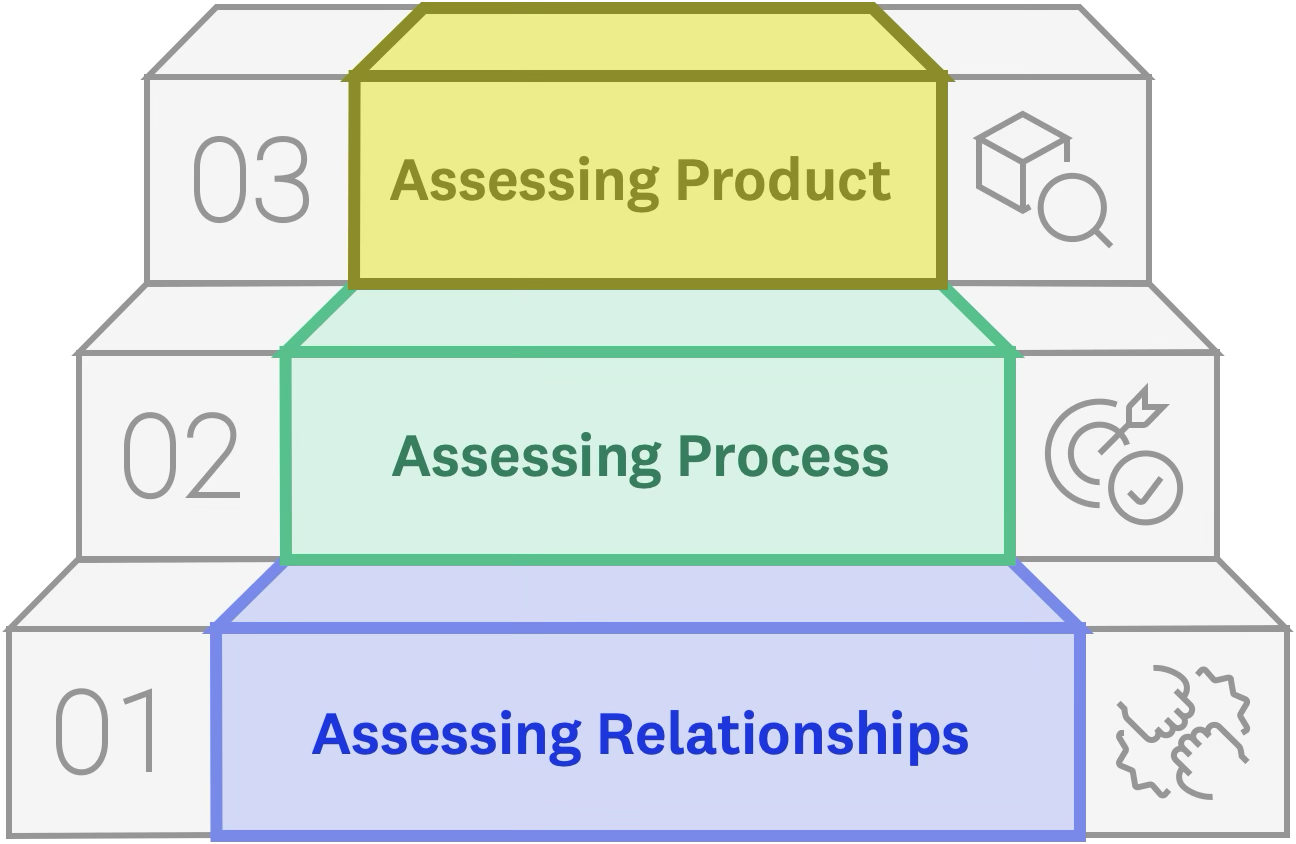Assessing by Design
Better Teams, Smarter Work, Stronger Product
Design is not a linear process—it is an ongoing cycle of exploration, iteration, and refinement. To build truly impactful products, teams must always be assessing—not just the final product, but the relationships that drive collaboration and the processes that shape the work.
This article explores three key areas where continuous assessment is critical:
Assessing Relationships: Building trust and fostering collaboration.
Assessing Process: Understanding where you are and what should come next.
Assessing Product: Measuring usability, impact, and business value.
By integrating assessment at every stage of a project, teams can ensure they are working effectively and driving meaningful outcomes.
Assessing Relationships: The Foundation of Collaboration
Design is not a solo effort. The success of a project depends on strong, trust-based relationships among designers, engineers, product managers, and stakeholders. Without trust, teams struggle to move quickly and effectively.
Key Questions to Ask
Am I building trust with my colleagues so we can move quickly and in unison?
Can everyone contribute meaningfully to solving the problem?
Are we creating a relationship of mutual benefit where collaboration strengthens the outcomes?
Building Trust in Design Teams
Trust isn’t just about personal rapport—it’s about congruence, consistency, credibility, and clarity.
Congruence – Do our words and actions align?
Consistency – Are we reliable and predictable in our work?
Credibility – Do we demonstrate expertise and accountability?
Clarity – Are we transparent about our decisions and thought processes?
By actively assessing and improving team dynamics, we create an environment where feedback is productive, decisions are respected, and collaboration leads to better outcomes.
Assessing Process: Navigating Complexity with Confidence
Understanding where you are in the process is essential for making the right decisions at the right time. Design is both expansive and focused—at times, teams must explore broadly, while at others, they must refine and converge.
Key Questions to Ask
What phase are we in—discovery, ideation, development, or delivery?
Are we solving the right problem before moving into execution?
Are we balancing expansion and focus at the right moments?
Designing the Right Thing vs. Designing Things Right
A successful process is not just about efficiency—it’s about ensuring that the work being done is solving the right problem.
Discover & Define: Research, insights, and problem framing.
Develop & Deliver: Iteration, validation, and implementation.
Many teams jump too quickly into high-fidelity design before fully exploring alternatives. Transparent processes allow for better decision-making and prevent wasted effort.
By continuously assessing process, teams stay adaptable, making informed decisions rather than reactive ones.
Assessing Product: Measuring Success Beyond Output
A common pitfall in product teams is focusing on output instead of outcomes. Just because a feature was shipped doesn’t mean it was successful. Instead, teams must measure the impact of their work on users and business goals.
Key Questions to Ask
Are we solving a real customer problem, or just shipping features?
What data and evidence are we using to improve user outcomes?
Are we validating usability, feasibility, and business impact?
Metrics That Matter
User Research:
Qualitative – Explains why things happen (e.g., interviews, observations).
Quantitative – Shows what is happening (e.g., analytics, A/B testing).
Product Success Metrics:
Usability Testing – Can users complete key tasks?
Engagement Metrics – Are users adopting and sticking with the product?
Business KPIs – Does the product contribute to revenue, retention, or other goals?
Overcoming Challenges in Measuring Impact
Many teams struggle to integrate business metrics into design because:
They are already overwhelmed with other priorities.
Cross-functional collaboration can be difficult.
Designers may not have direct access to key business data.
How to Overcome These Challenges
Set clear metrics at the start of every project.
Collaborate with business and customer success teams to define shared goals.
Use both qualitative and quantitative insights to tell a complete story.
By shifting focus from output to outcome, design teams can prove their impact, advocate for better user experiences, and contribute meaningfully to business success.
Always Be Assessing
Great design is not about one perfect process—it’s about continuous assessment and iteration. By regularly evaluating relationships, process, and product, teams ensure they are working effectively, making informed decisions, and delivering meaningful results.
To embed assessment into your design practice, ask yourself:
Are we building strong relationships that foster collaboration?
Are we navigating the process with clarity and purpose?
Are we measuring success based on real impact, not just deliverables?
By always assessing, design teams don’t just create better products—they build stronger teams, smarter workflows, and more valuable outcomes.
How does your team approach continuous assessment? Let’s connect and discuss!
